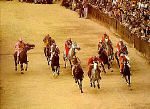Palio di Siena: More than Just a Horse Race

The husband and I visited Siena in late July 2001, and – like many who visit the city – we loved it. We stayed at a B&B within the old city walls in a room with a frescoed ceiling and a view overlooking the Tuscan hills. We wandered the winding streets, visited the striped cathedral and the husband even got in a morning bike ride through the Chianti region. It was lovely.
Our visit fell between the two runnings of Siena’s Palio. The Palio, run every year on July 2 and August 16, is a bareback horse race around Siena’s main square, il Campo. It’s a tradition that dates back to the 1600s, and it pits the city’s districts, or contrade, against one another in what can’t even be described as a “friendly rivalry.”
When we were there, there were no horses to be seen, but there was sand between the stones of il Campo, and each contrada still proudly displayed its banners on the streets. One night while we ate dinner at an outdoor table, we heard drumbeats. We quickly finished our meal and set out to find them. It turned out one of the contrade was marching through the town, eventually spilling into il Campo, with a full-on marching band and banner-bearers (the giant square flags aren’t just waved, they’re tossed high into the air and caught on their way back down) followed by residents of that neighborhood wearing the contrada scarves and singing the contrada songs. Since we couldn’t be there for the race itself, it was fun to see something of the tradition manifest itself in what seemed like a wonderfully spontaneous way.
The other night we watched a film called “The Last Victory” about the July 2003 Palio, which tells the story from one contrada‘s perspective (Civetta, or Owl). It does a beautiful job of showing not only how important the contrada is to each resident, but also how important the Palio is to the contrade.
Some history from the Palio website:
“Piazza del Campo” is still used today for the well known Palio horse race which is one of the most famous popular Italian manifestations. It takes place every year on July 2 and August 16. The Palio is run to celebrate the miraculous apparition of the Virgin Mary near the old houses that belonged to Provenzano Salvani. The holy apparition was therefore called “Madonna di Provenzano” in whose honour the very first Palio was run on August 16, 1656. The Palio was run for the first time in 1701 in honour of the “Madonna dell’Assunta” the patroness and Advocate of Siena through all the tragic events since she protected the Sienese militia at the famous battle of Monteaperti on September 4, 1260, against the Florentines.
The Palio is a historical secular tradition strictly connected with the origin of the Contradas of Siena (districts into which the town is divided). The Contradas are spectacular agonistic institutions each having their own government, oratory, coat of arms, appellations, sometimes titles of nobility, emblems and colours, official representatives, festivities, patron Saints, with protectors, delimited territories and population which consist of all those people who were born or live within the topographic limits of the district, according to the proclamation issued by Violante Beatrice of Bavaria on January 7, 1730, at that time, Governess of the town.
Originally, there were about fifty-nine “Contrade”; now only seventeen remain, ten of which take part in the historical pageant and in the race at each Palio (seven by right and three drawn by lots).
The emphasis on the “secular” and “agnostic” elements of the Palio goes hand in hand with the city of Siena. Instead of a church tower marking the city center, it’s the town hall that holds court at the bottom of il Campo.
There is a ton of great information on the Palio (some of it in English) at the website, including a list of all the winners going back to 1644 (it’s in Italian, but it’s still fun to see the history, and you can cross-reference the names of the contrade with their animal names here). There’s also an FAQ in English and the schedule of events (both extremely useful if you’re thinking of visiting Siena during the races), and more history here.
Finally, here’s a video of the August 2005 Palio, which was won by the Torre contrada – a contrada which hadn’t won a Palio since 1961. As you can imagine, the residents of the Torre contrada went nuts afterwards. It’s a delight to watch, even if you can’t understand Italian. We can all understand joy.